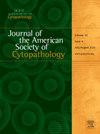Spontaneous clots in body fluids: can they cellblock?
Q2 Medicine
Journal of the American Society of Cytopathology
Pub Date : 2025-09-01
DOI:10.1016/j.jasc.2025.04.005
引用次数: 0
Abstract
Introduction
Cell blocks have become a critical component in the diagnostic and prognostic analysis of cytologic specimens. Yet, it is common for cell blocks to lack sufficient cellularity for assessment and ancillary testing. Assessing cellularity in spontaneous clots that form in body fluids can aid in improving cell block utilization.
Materials and methods
Eighteen body fluid specimens originally submitted for cytologic evaluation were selected for processing. For each fluid, 2 cell blocks were made, 1 using the spontaneous clot (SC) and 1 using the cell pellet (CP) from only the concentrated fluid. A hematoxylin and eosin-stained slide for each block was assessed for cellularity and ranked on a scale from 0 to 3. A score of 0 represented no cells present, while a score of 3 represented abundant cells of interest present.
Results
For the CP blocks, 28% had a cellularity score of 0, 44% had a score of 1, 11% had a score of 2, and 17% had a score of 3. For the SC blocks, only 6% had a cellularity score of 0, 39% had a score of 1, 28% had a score of 2, and 28% had a score of 3.
Conclusions
Cell blocks prepared using the SC method resulted in an overall higher cellularity compared to the CP blocks. The SC blocks prepared from malignant fluids also showed denser areas of pure tumor nuclei. This resulted in adequate spontaneous clot blocks for genomic testing, while the corresponding CP block was only adequate for diagnostic purposes.
体液中的自发血块:它们会阻塞细胞吗?
细胞阻滞已成为细胞学标本诊断和预后分析的关键组成部分。然而,细胞块缺乏足够的细胞量用于评估和辅助测试是很常见的。评估体液中形成的自发血块的细胞性有助于提高细胞阻滞的利用率。材料和方法:选择原提交细胞学评价的18份体液标本进行处理。对于每种液体,制作2个细胞块,1个使用自发凝块(SC), 1个使用仅来自浓缩液体的细胞颗粒(CP)。每个块的苏木精和伊红染色的载玻片被评估细胞度,并在0到3的范围内排名。0分表示没有细胞存在,而3分表示存在大量感兴趣的细胞。结果:对于CP块,28%的细胞度评分为0,44%的评分为1,11%的评分为2,17%的评分为3。对于SC块,只有6%的细胞度得分为0,39%的细胞度得分为1,28%的细胞度得分为2,28%的细胞度得分为3。结论:与CP块相比,SC方法制备的细胞块总体上具有更高的细胞密度。从恶性液体中制备的SC块也显示出更密集的纯肿瘤核区域。这导致了足够的自发凝块用于基因组检测,而相应的CP块仅用于诊断目的。
本文章由计算机程序翻译,如有差异,请以英文原文为准。
求助全文
约1分钟内获得全文
求助全文
来源期刊

Journal of the American Society of Cytopathology
Medicine-Pathology and Forensic Medicine
CiteScore
4.30
自引率
0.00%
发文量
226
审稿时长
40 days
 求助内容:
求助内容: 应助结果提醒方式:
应助结果提醒方式:


